Menus
- Best mid-range naked bike?
- Remaining range display no great help
- With a full tank it weighs 187 kilograms
- Uncertainty due to slippery seat covers
- Brake finely adjustable
- Full range of electronics and driving aids
- MOTORCYCLE conclusion
- The competition
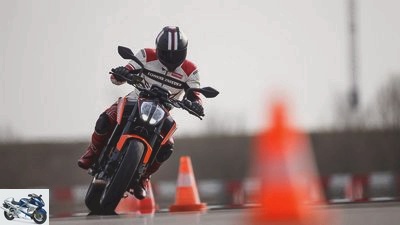

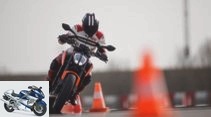
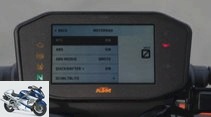
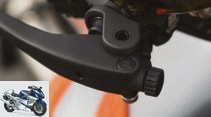
18th photos
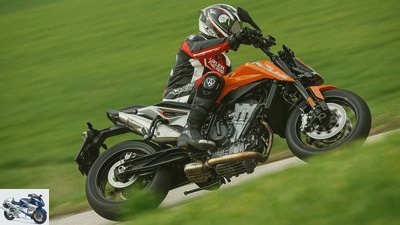
jkuenstle.de
1/18
KTM 790 Duke in the top test.

2/18
With its angular shapes and sharp lines, the 790 Duke is instantly recognizable as a KTM.
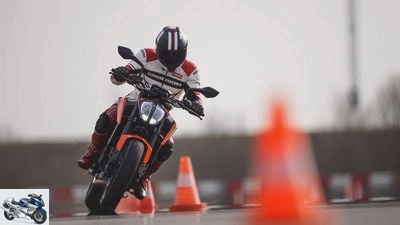
3/18
The chassis is designed for stability, but the lightweight 790 wags nimbly through the course.
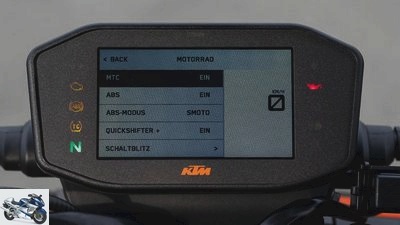
4/18
The display – here in setting mode – is clear, the menu navigation is logical.
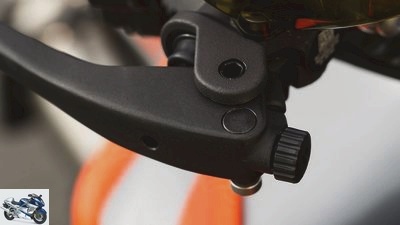
5/18
The adjustment of the brake lever cannot be seen from the driver’s seat and can hardly be operated.
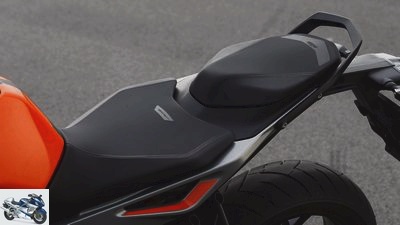
6/18
If you ride in leather, you slide back and forth, back and forth on the smooth bench.
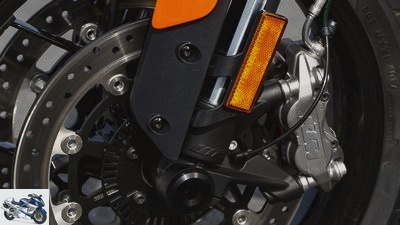
7/18
The brakes with 300 discs work perfectly – stable, snappy, but easy to dose.
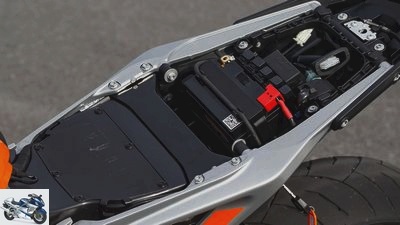
8/18
Orderly: The wiring harness runs in a separate channel (left), relays and fuses are neatly lined up, but the diagnostic connector has no cover (right).
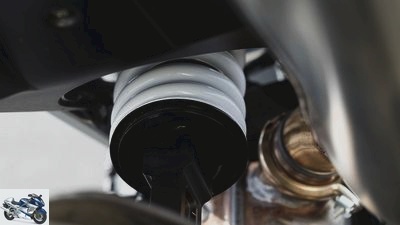
9/18
The directly linked and non-adjustable WP shock absorber responds insensitively.
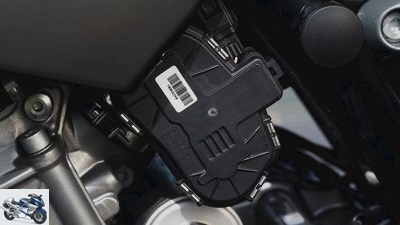
10/18
Throttle valve actuator: Interface for traction control and quickshifter.
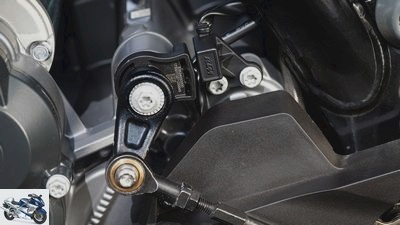
11/18
The sensors of the Quickshifter are housed in a protected place.
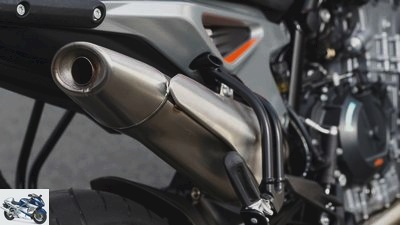
12/18
Valuable appearance: You can have different opinions about the shape of the silencer, but not about the design of the entire exhaust system. It consists entirely of stainless steel parts that are welded with fine seams. A sight that one likes to see.
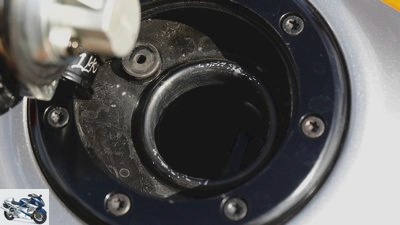
13/18
Paint is coming off: The paint around the filler neck began to come off after the first refueling. Mechanical damage is not the cause, but insufficient petrol resistance. The detached particles are not particularly large, but will settle in the gasoline filter over time. In the best case.

14/18
Once the ABS lost control of the lifting rear wheel during the braking measurements.
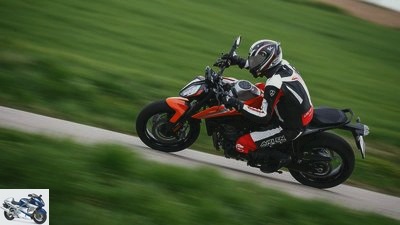
15/18
The 790 Duke is a very sporty naked bike with a dominant engine.

16/18
The KTM is not a bike that wants to please everyone. You should have a sporty driving style, physical commitment and a lot of feeling in handling the accelerator and brake levers.
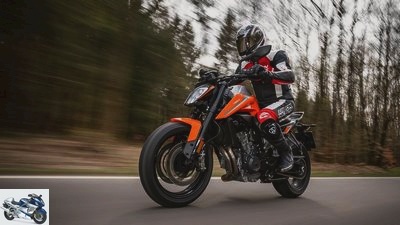
17/18
In return, for an acceptable price, there is a careful workmanship including extensive equipment, a spirited engine and a tightly tuned chassis.

, Yamaha
18/18
The competition: Ducati Monster 821 (l.o.), Suzuki GSX-S 750 (r.o.) and Yamaha MT-09 (below).
KTM 790 Duke (2018) in the top test
Best mid-range naked bike?
Until now, KTM has only built single-cylinder and V2 engines in series. Now the Austrians are bringing their first in-line engine with two cylinders in the KTM 790 Duke. It closes the gap between the 690 and the 1290 Duke and is the pioneer of a new generation of models.
The engine starts. That’s what we say, and everyone understands. But with the KTM 790 Duke it has to be said: The engine starts me. Of course, this sentence is not to be taken literally, but in a figurative sense aptly describes what happens when the first ignitions hit your ears. The new in-line twin cylinder demands, maintains and keeps irresistibly KTM attracts the driver’s attention. This is initially a purely acoustic phenomenon; The rhythm and the exhaust sound leave no other impressions besides. Thanks to a crank pin offset of 75 degrees, the in-line engine sounds like the big V2 from KTM, developing the same beguiling “groove”.
Buy complete article
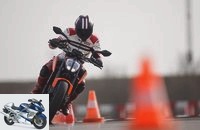
KTM 790 Duke (2018) in the top test
Best mid-range naked bike?
Engine of the KTM 790 Duke a stunner
Listening pleasure is not the only attraction that the drive of the KTM 790 Duke has to offer. There is something electrifying about the way it tears while driving, revs up, slams towards the peak of performance, accompanied by a swelling wave of sound. You want to experience it again and again and completely forget that it is “only” a mid-range engine that drives you. The low flywheel mass and the responsive throttle valve control play an important role as further ingredients of this experience package. The flaps are operated by a servomotor on the left side of the throttle body, but even in the relatively tame “Street” mode it feels as if they are attached to the throttle grip. On a very smooth throttle.
With its angular shapes and sharp lines, the 790 Duke is instantly recognizable as a KTM.
In some situations this ease of movement and the spontaneous reactions to it can be annoying. For example, when you cannot indulge in the pleasure of sporty driving on the open road, but are forced to seep into a big city on congested streets. The drive of the KTM 790 Duke can be as irritating as someone who is quietly called by name, but who then immediately jumps up and asks in a loud voice: “What?”
Remaining range display no great help
Only from around 3,500 rpm and only with great discipline on the throttle is it possible to some extent to prevent pronounced constant-speed jerking. And only with great care and determination can the driver avoid unnecessary load changes on an unknown, winding route that spoil his rhythm and a fluid line. All of this can be achieved, no question about it, and it’s just the other side of a fascinating temperament. Motorcyclists who are interested in the KTM 790 Duke should, however, know what they are getting into, what they have to bring in to make the most of their driving pleasure potential and where they simply have to put up with minor annoyances. Apart from the choppy engine running at low speeds and the aforementioned constant jerk, the series twin runs very cultivated thanks to the two balancer shafts. How highly developed he is can also be seen in his moderate thirst for petrol. He completed the consumption lap with exactly four liters of super per 100 kilometers. Despite the not exactly large 14-liter tank, you can theoretically travel 350 kilometers, and even if the temperament of the driver and that of the engine rock each other, it is still enough for over 200 kilometers.
The display – here in setting mode – is clear, the menu navigation is logical.
The remaining range display is of no help when planning the next refueling stop. She calculates too slowly and knows no turning back. After around 20 kilometers of full throttle on an empty motorway in the evening, the predicted remaining range fell suddenly from 110 to 70 kilometers, previously it had been reduced by ten kilometers every five kilometers. And when the tank-lazy driver slowed down, the 70 kilometers stopped for almost 40 kilometers. So you can wait to refuel until the reserve display of the KTM 790 Duke makes its dramatic appearance and suppresses all other information from the display instrument – with the exception of the legally required speedometer, of course.
With a full tank it weighs 187 kilograms
The aforementioned full throttle drive was not primarily used to test the fuel management of the on-board computer, but to test the driving stability at high speeds. On the corresponding section of the motorway, which slams into the chassis in rapid staccato with hearty transverse joints, many motorcycles have already found themselves in unstable driving conditions from swinging around the vertical axis to knocking the handlebars. Not so with the KTM 790 Duke. It passed the bumps on to the driver hardly at all, but kept the course stable. The relatively long wheelbase, long caster and steering damper help here. 140 millimeters of suspension travel on the fork with a correspondingly high negative proportion do the rest, despite aerodynamic lift on the front axle, to keep the front wheel on the ground and thus in its management tasks.
On the other hand, the low weight of 187 kilograms with a full tank makes the KTM 790 Duke easy to handle. The relatively wide handlebars produce a decent steering torque with little force, the narrow and light crankshaft does not allow too great a moment of inertia, and so the Duke willingly steers. Even at higher speeds. With a very sporty driving style and in the slow slalom of the top test course, however, the testers noticed diffuse feedback from the front wheel, an uncertainty regarding guidance and tire grip. Involuntarily, they responded by being more careful in the first phase up to the apex. This is not a driving impression that you are immediately aware of, but that crystallizes in the follow-up.
Uncertainty due to slippery seat covers
The rear tire stood out better than its front partner. When accelerating sharply in an inclined position, it offered a lot of grip and gave a safe feeling. When the test machine came to the editorial office with barely 1,000 kilometers on the speedometer, it was already visibly gone in the middle. The slightly angular tread could be one reason for a noticeable righting moment, which the KTM 790 Duke shows in an inclined position at low speeds. How the wet grip of the Maxxis tires is, could not be clarified in this test. It only rained briefly during a ride in rush hour traffic.
If you ride in leather, you slide back and forth, back and forth on the smooth bench.
The Duke’s decent, but somewhat below expectations, values in the slow slalom of the top test course are not only due to the feedback from the front tire. The slippery seat cover caused a lot of uncertainty when cornering. If you ride the KTM 790 Duke in the leather suit, you feel like a drop of water sliding off a lotus flower when you tilt. When accelerating and braking, the driver has to support himself with all his strength and all tricks in order not to slide back and forth unsteadily. The rougher seats of textile trousers offer better support; However, wearing these should not be a compulsion.
Brake finely adjustable
The KTM 790 Duke benefits from its long wheelbase not only when it comes to straight-line stability, but also when braking. In conjunction with the well-coordinated ABS, it showed high braking stability. Although the reference, the Ducati 821, slows even faster, 9.6 m / s² is an excellent value as an average deceleration from 100 km / h. After several measurements and only once, however, the rear wheel rose suddenly and went off track. The ABS could no longer defuse the situation, and tester Georg Jelicic had to release the brake to avoid a rollover. It was not possible to clarify whether he suddenly slid forward on the smooth bench or whether the high temperatures in the brake system or both together triggered this outlier. In any case, the homogeneous asphalt surface on the Bosch test site in Boxberg cannot be the reason.
The brakes with 300 discs work perfectly – stable, snappy, but easy to dose.
On this side of the emergency braking on the test site, the Duke’s brake liked with its spontaneous bite and stability. It can also be finely dosed, but requires some getting used to. If you switch from a motorcycle with duller brakes, you will initially pull too hard on the lever and suddenly decelerate. The almost unfiltered transmitted bumps have already been mentioned in connection with the high-speed stability. It has to be added that the KTM 790 Duke also has little suspension comfort to offer, despite long suspension travel of 140 millimeters at the front and 150 millimeters at the rear. The reason for this is less to be found in the coordination of fork and shock absorber, but in their insensitive response. With the WP fork, friction and hydraulic damping add up in such a way that it can be pinned in a range of several centimeters around the zero position, regardless of whether the front is lifted or pushed down. Fine response is different.
Full range of electronics and driving aids
While the spring mechanism of the KTM 790 Duke has been kept rather simple, it offers the full range of electronics and driving aids. A pleasant surprise given the moderate price. Four driving modes, ABS, supplemented by the bankable MSC control, traction control, drag torque control, shift assistant, shift light, race start assistant and even a tire pressure sensor – there is a lot to learn and adjust for the money. In practice, you can confidently confine yourself to the “Street”, “Sport” and “Rain” driving modes, and even with a sporty driving style, “Street” mode leaves little to be desired for a sharper throttle response or later intervention by traction control. If you still want to use the freely configurable “Track” mode, you don’t even have to try levels eight to six of the traction control on dry roads, but can orientate yourself straight away in the direction of five or two. The ABS mode “Supermoto” deactivates the rear wheel ABS and obviously also the rollover detection, because high stoppies could be reproduced in a few attempts. The hindquarters snap up so quickly that it is better not to use this mode in public transport.
Once the ABS lost control of the lifting rear wheel during the braking measurements.
The KTM 790 Duke is functional, but carefully processed, surfaces, welds and the electrical installation make a valuable impression. Many details have been cleverly solved, for example the plastic tank cover. In the event of a fall or if the machine falls over, it protects the tank. If it is damaged, it is relatively easy to replace and would even hide any dents in the tank in a friendly manner. If the tank is hit on the exposed and visible top, you usually have bigger problems than sheet metal damage anyway.
MOTORCYCLE conclusion
No, the KTM 790 Duke doesn’t want to please everyone. She expects her driver to have a sporty driving style, physical effort and a lot of feeling in handling the throttle and brake lever. In return, it offers an extremely spirited engine, a tightly tuned, uncomfortable chassis, careful workmanship and extensive equipment at an acceptable price.
The competition
Ducati Monster 821
Two-cylinder V-engine, 109 hp, weight 213 kg, 0-100 km / h 3.3 seconds, Vmax 225 km / h, consumption 5.1 liters, 11,795 euros
Suzuki GSX-S 750
Four-cylinder in-line engine, 114 hp, weight 214 kg, 0–100 km / h 3.4 seconds, Vmax 225 km / h, consumption 4.7 liters, 8,319 euros (special offer)
Yamaha MT-09
Three-cylinder in-line engine, 115 hp, weight 195 kg, 0-100 km / h 3.4 seconds, Vmax 210 km / h, consumption 4.4 liters, ABS, 10-375 euros
Related articles
-
factstudio.de 15th photos factstudio.de 1/15 Honda CB 1000 R + in the top test. factstudio.de 2/15 The design line of the new CB 1000 R is called “Neo…
-
Driving report KTM 790 Duke 2018
KTM 38 photos KTM 1/38 KTM builds its first two-cylinder in-line engine and puts it into the completely newly developed 790 Duke. The aim: to produce the…
-
KTM 1290 Super Duke GT in the PS driving report
KTM 13 pictures KTM 1/13 KTM 1290 Super Duke GT. KTM 2/13 KTM 1290 Super Duke GT. KTM 3/13 The right fork leg (red plug above) houses …
-
Comparison test KTM Duke against MuZ Mastiff
Comparison test between KTM Duke and MuZ Mastiff Must be fun Who says that a serious comparison test shouldn’t also be murderous fun. KTM …
-
KTM 1290 Super Duke R in the top test
Jahn 29 pictures Jahn 1/29 Jahn 2/29 Impressive: the increase in torque at 6000 rpm. Jahn 3/29 Jahn 4/29 Mitterbauer 5/29 Edged game: The super …
-
Driving report KTM 1290 Super Duke R
Photo: KTM 23 photos KTM 1/23 There is no competition! Pithy words, but you have to agree with KTM press man Thomas Kuttruf. KTM 2/23 The seat and rear…
-
Fantic Caballero Scrambler Flatracker 250 500 review 2018
New items 2019 Top topic Kel Edge 17th photos Kel Edge 1/17 Fantic is celebrating its street comeback with a new edition of the Caballero. Kel Edge 2/17…
-
KTM 690 Duke R and Suzuki GSR 750 in comparison
fact 18th photos fact 1/18 In the end, the Suzuki GSR 750 ABS had to admit defeat to the KTM 690 Duke R.. fact 2/18 The double floating saddle system…
-
KTM 690 Duke put to the test – the cornering machine from KTM
20th photos 1/20 Such deposits are no problem for the single. 2/20 Also available in black – the KTM 690 Duke….
-
Bilski 10 photos Bilski 1/10 The large single-cylinder Duke is an entertaining curve finder with a high fun factor, even with braked foam. Bilski 2/10 A…